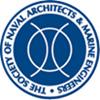EFD and CFD Study of Forces, Ship Motions, and Flow Field for KRISO Container Ship Model in Waves
IF 1
4区 工程技术
Q3 ENGINEERING, CIVIL
引用次数: 12
Abstract
Ship motion responses and added resistance in waves have been predicted by a wide variety of computational tools. However, validation of the computational flow field still remains a challenge. In the previous study, the flow field around the Korea Research Institute for Ships and Ocean Engineering (KRISO) Very Large Crude-oil Carrier 2 tanker model with and without propeller condition and without rudder condition was measured by the authors, as well as the resistance and self-propulsion tests in waves. In this study, the KRISO container ship model appended with a rudder was used for the higher Froude number .26 and smaller block coefficient .65. The experiments were conducted in the Osaka University towing tank using a 3.2-m-long ship model for resistance and self-propulsion tests in waves. Viscous flow simulation was performed by using CFDShip-Iowa. The wave conditions proposed in Computational Fluid Dynamics (CFD) Workshop 2015 were considered, i.e., the wave-ship length ratio λ/L = .65, .85, 1.15, 1.37, 1.95, and calm water. The objective of this study was to validate CFD results by Experimental Fluid Dynamics (EFD) data for ship vertical motions, added resistance, and wake flow field. The detailed flow field for nominal wake and self-propulsion condition will be analyzed for λ/L = .65, 1.15, 1.37, and calm water. Furthermore, bilge vortex movement and boundary layer development on propeller plane, propeller thrust, and wake factor oscillation in waves will be studied.KRISO集装箱船波浪模型中力、船舶运动和流场的EFD和CFD研究
船舶在波浪中的运动响应和附加阻力已经通过各种计算工具进行了预测。然而,计算流场的验证仍然是一个挑战。在之前的研究中,作者测量了韩国船舶与海洋工程研究所(KRISO)2号超大型原油运输船模型在有螺旋桨和无舵条件下的流场,以及波浪中的阻力和自推进试验。在这项研究中,带有舵的KRISO集装箱船模型被用于较高的弗劳德数.26和较小的阻塞系数.65。实验在大阪大学的拖曳舱中进行,使用3.2米长的船模型进行波浪阻力和自推进试验。使用CFDShip Iowa进行粘性流动模拟。考虑了2015年计算流体动力学(CFD)研讨会中提出的波浪条件,即波船长度比λ/L=.65、.85、1.15、1.37、1.95和平静水。本研究的目的是通过船舶垂直运动、附加阻力和尾流场的实验流体动力学(EFD)数据验证CFD结果。对于λ/L=.65、1.15、1.37和平静水,将分析标称尾流和自推进条件下的详细流场。此外,还将研究舱底涡流在螺旋桨平面上的运动和边界层发展、螺旋桨推力和波浪中的尾流因子振荡。
本文章由计算机程序翻译,如有差异,请以英文原文为准。
求助全文
约1分钟内获得全文
求助全文
来源期刊

Journal of Ship Research
工程技术-工程:海洋
CiteScore
2.80
自引率
0.00%
发文量
12
审稿时长
6 months
期刊介绍:
Original and Timely technical papers addressing problems of shipyard techniques and production of merchant and naval ships appear in this quarterly publication. Since its inception, the Journal of Ship Production and Design (formerly the Journal of Ship Production) has been a forum for peer-reviewed, professionally edited papers from academic and industry sources. As such, it has influenced the worldwide development of ship production engineering as a fully qualified professional discipline. The expanded scope seeks papers in additional areas, specifically ship design, including design for production, plus other marine technology topics, such as ship operations, shipping economic, and safety. Each issue contains a well-rounded selection of technical papers relevant to marine professionals.
 求助内容:
求助内容: 应助结果提醒方式:
应助结果提醒方式:


